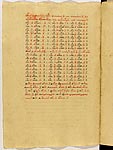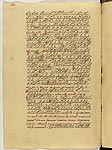Notated Collection of Vocal Music.
Late 16th cent. [1589-1591]
 |
 |
 |
Fol. 152r |
Fol. 159v |
Fol. 420v |
F (287 § 192). 832 leaves.
Paper. Ink, cinnabar.
It is written in a semi-uncial script by several hands.
Znamenny notation without red-ink marks (known as the Shaidurov's marks) and black line-signs (the priznaki of Mezenets). Folio 170v has the sign "▌" on it. Folio 760v contains corrections to a note line written in cinnabar.
The illumination of the manuscript includes the full-page pen-and-ink miniature "The Tree of Life" showing animals and birds (fol. 3v). There are ornamental head-pieces with plant-motifs in the Early Printed style in ink (in colours on fol. 168r). The picture of a lion is in the centre of the head-piece on fol. 500r. Fols. 4r, 318r, 430r are decorated with initials with plant-motifs in cinnabar, initials with geometric motifs in ink are on fols. 219r, 273r. Heading are written with use of ligatures. The edge of the text block are adorned with patterned stamping and toned with gold.
The manuscript comprises all books of vocal music, necessary for liturgical services. Each of them is distinguished for its comprehensiveness. This is an exemplary code containing almost complete vocal information, developed by the time of its creation. There are divers opinions on the origin of the manuscript. The assumption is that it was created at the Stroganovs' shop devoted to the copying of manuscripts, which was located in Sol' Vychegodskaya (N. Seregina, N. Parfent'ev, N. Parfent'eva). From the other point of view, the codex was written and decorated in Moscow (N. Ramazanova, R. Khachan'ian, A. Kruchinina, M. Vasilik). Before the creation of manuscript, there was a need to do big initial preparatory work on collecting musical hymnographic materials from every corner of Russia and adaptation of them. It was a question of great importance to the Russian Ordodox Church, equal in value, trend and amount of work to work of Metropolitan Macarius on the Great Monthly Readings. It could be carried out only centralizedly. The manuscript was not intended for liturgical practices, it was produced to serve as a model for copying. An evidence of that is, firstly, the excellent condition of paper and the binding and, secondly, the fact that the codex was bound at a much later date, in the 1730s. The lack of traces of stitching of paper block points out that the book had not originally any binding. It was an easier task to take unbound books to parts and give them to scribes for copying.
The manuscript contains a record stating that it was donated to the Kirillo-Belozersky Monastery by officials after making list of items of property and the library. The inventory was done by Clerk Prokof'ev and Stolnik Sitsky - by order of Tsar Mikhail I Feodorovich Romanov.
The comprehensiveness of the codex, texts of hymns to Russian and ecumenical saints representing the ideology of the Moscow state, the thoroughness of the scribes' work, the symbolic meaning of the artistic decoration of the manuscript, its donation to the Kirillo-Belozersky Monastery made by official persons - this all is an evidence of Moscow origin of the book. It was impossible to prepare such manuscript in the distance from main centers for church music. The manuscript was a result of reforms carried out during the 16th century, aimed to correct defects of liturgical practices in the Russian Church. In addition, it was dedicated to reflect the principal ideology of the Russian state, like other historical and literary memorials of medieval Russian book art dating from that period, namely the 16th-century Illuminated Compiled Chronicle, the Stepennaia Kniga (The Book of Degrees of Royal Genealogy) and the Great Monthly Readings.
In 1918 the manuscript came into the State Public Library along with the other materials from the library of the Kirillo-Belozersky Monastery.
Shelfmark: ą═┴. ╩Ķ.-┴Õļ. 586/843.




